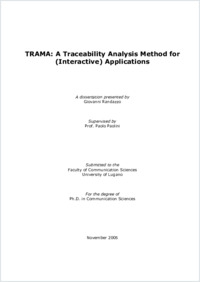TRAMA : a traceability analysis method for (interactive) applications
- Randazzo, Giovanni
- Paolini, Paolo (Degree supervisor)
-
20.12.2005
160 p
Thèse de doctorat: Università della Svizzera italiana, 2005 (jury note: magna cum laude)
English
A common opinion in the Requirements Traceability field is that solution design, i.e. the design of the application solutions, may be derived directly from requirements refinement; according to current industrial practices and to some specific experiences, this dissertation proposes a different thesis: the design process is not a fully rational and explicit sequence of actions; designers keep requirements in mind as a background knowledge, and they build up the application architecture almost from scratch, as a result of a an inductive and in part intuitive activity. Since requirements are understood as base information about how the application should be and why, skilled designers are able to draw a design that satisfy in a certain measure those requirements. In common industrial cases these relationships are anyway still not explicitly specified; this problem make very hard to verify, to evaluate, to revision and to reuse efficiently design solutions in relation with high-level requirements. This dissertation presents TRAMA (Traceability Analysis Method for [interactive] Applications), an effective method to discover, elicit, analyse and document "ex-post" traces, i.e. the method does not record the design process but helps designers in understanding both the impact of requirements in their projects and the motivations and the sources of specific design decisions after the design has been drawn. The method is based on traceability matrices that cross requirements with design in a forward direction and design with its sources (requirements, motivations, constraints, etc.) in a backward direction. Requirements-to-Design matrix called RIM (Requirements Impact Model/Matrix) can be filled and read both horizontally, highlighting how single requirements are taken into account into the design, and vertically, showing how a single design element satisfies the project requirements. Design-to-Sources matrix called DMM (Design Motivations Model/Matrix) traces back single design elements to the motivation why a certain decision is relevant for the project, e.g. satisfying a requirements, fulfilling a constraint, allowing more usability in the system, etc. Benefits of this method are providing designers with: (a) a powerful communication mean to show to the clients that all their requirements have been considered and how, and that there are not unmotivated elements in the design; (b) a structured practice to check design consistency for revision; (c) an advanced tool to tune up design in maintenance phase; (d) a complete project knowledge summary of requirements, of design elements and of relationships between them, as vital information allowing an effective system reengineering.
- Language
-
- English
- Classification
- Computer science and technology
- License
-
License undefined
- Identifiers
-
- RERO DOC 6124
- URN urn:nbn:ch:rero-006-108411
- ARK ark:/12658/srd1318114
- Persistent URL
- https://n2t.net/ark:/12658/srd1318114
Statistics
Document views: 411
File downloads:
- Texte intégral: 206
